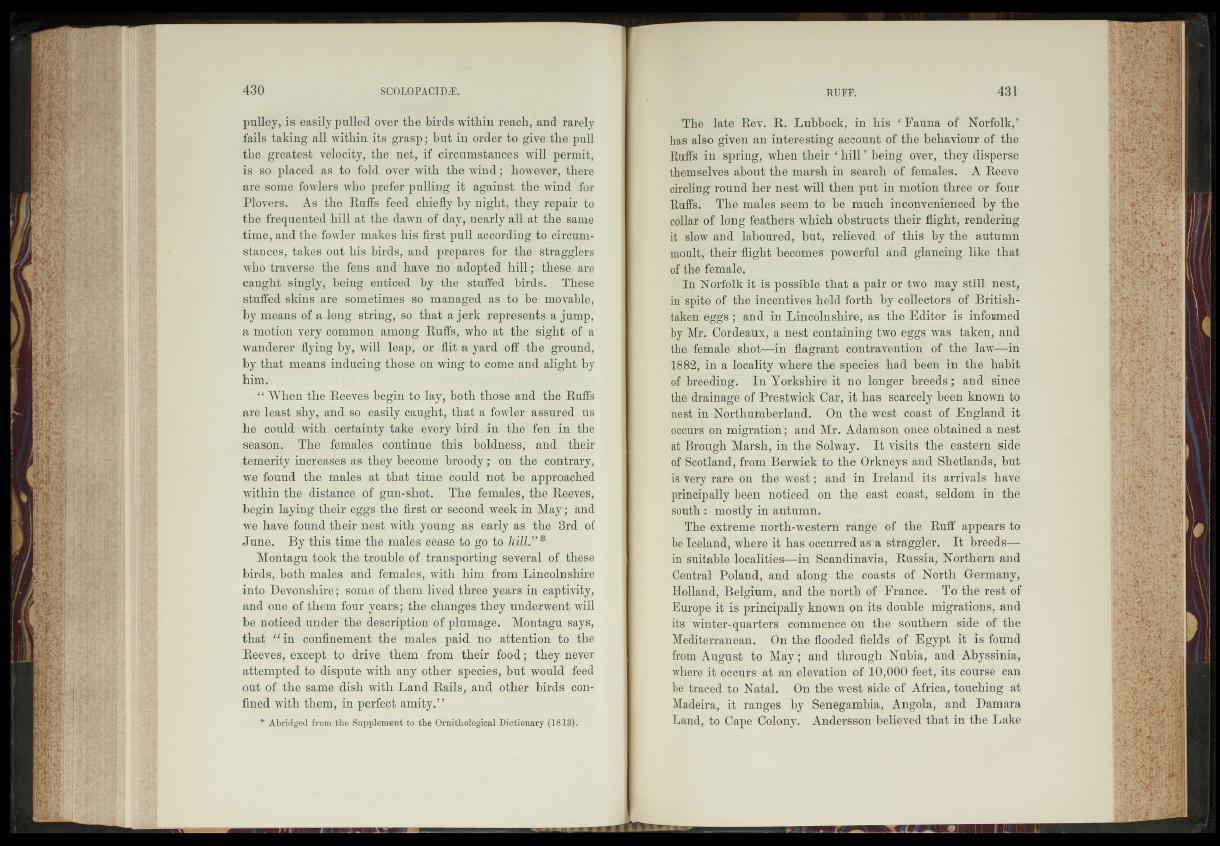
pulley, is easily pulled over the birds within reach,'and rarely
fails taking all within its grasp; but in order to give the pull
the greatest velocity, the net, d£ circumstances will permit,
is so placed as to fold over, with the wind; however, there
are some fowlers who prefer pulling M, against the wind for
Hovers. As the Ruffs feed chiefly by night, they repair to
the frequented hill at the dawn of day* nearly all at the same
time, and the fowler, makes his first pull according to circumstances,
takes out his birds, and prepares for the stragglers
who traverse the fens and have no adopted hill ; these are
caught singly, being enticed 'by 4he stuffed birds. .These
stuffed skins are sometimes so managed as to be movable,
by means of a long; string, so that a jerk represents a jump,
a motion very common among Ruffs, who at the sight of a
wanderer flying by, will' leap, or flit a yard off the ground,
by that means inducing those on wing’ to eome and alight by
him.
i,.“ When the Reeves begin to Iky, both those and the Ruffs
are least shy, and so easily caught, that a. fdwler assured us
he could-with certainty take every bird -in, ,the, :fen in.,the
season. . The females continue this boldness,-: and/.their
temerity increases as .'they become" broody'; on the contrary,
we found.’.the males at that time) c<pi4; not be approached
within the. distance of gun-shot. The females,,the Reeves,
begin laying' their eggs.-the first Or second week in May,; and
we have found their-nest with. ■,young' as, early as the -3rd of
June. By this-time the males cease to go to
Montagu took the trouble of transporting several o£ these
birds, Roth males and females, .with him from Lincolnshire
into Devonshire; some of them lived three years in Captivity,
and/one. qf them four years ;Ahe changes they underwent will
be noticed under the description of plumage. Montagu says,
that “ in confinement the males paid no attention to the
Reeves, except to/.drive Jhem from their food; they never
attempted to dispute-with any ether:,species, but would feed
out pf the same dish with Land Rails, and other .birds confined
with them,, in perfect amity.”
■ * Abridged fram-tie Supplement to-the Ornithological Dictionary (181S)3MThe
late Rev. R. Lubbock, in his ‘ Fauna of Norfolk, ’
has also given an interesting account Of the behaviour of the
Ruffs in spring, when their ‘hill’ being over, they disperse
themselves about the marsh in search of females. A Reeve
circling round her nest will then put in motion three or four
Ruffs. The males seem to be much inconvenienced by the
collar of long feathers which obstruets^their flight, rendering
it slow and laboured, but, relieved of this by the I autumn
moult, their flight becomes powerful and glancing like that
of the'female.
In N'orMk it is possible that a pair or two may still nest;
imipite of the' incentives'held forth by collectors of British-
taken eggs ; and Hfe Lincolnshire», as the Editfear is informed
by Mr. Cordeaux;-’a nest 'containing two eggs was taken, and
the female ' shbt-i—in flagrant contravention of the law—in
1882/in a locality where the species had been in the habit
of breeding. In Yorkshire it nô longer breeds) 'and since
th% drainage: of Prestwick Car, ijThas scarcely been known to.
nest in Northumberland. On the west coast ) of England it
oÇctirs on'migration; and‘Mr. Adamsbn^dhce obtained a nest
at Brough Marsh, in the Solway. ? It v is its e a s te r n - s id e
of Scotland, from Berwick-to the Orkneys and Shetlands, but
iPrery rare on the west ; and in Ireland its arrivals havè
principally been noticed .on ,the/east .coaÉtjï seldom' in the
south 4; mostly in autumn)
* The extreme north-western range the Ruff appears to
be Iceland, where it has occurred as a straggler. ' It breeds—
in suitable localitiesfelhirScandinavia, Russia, Northern and
Central Poland, and along the .coasts of North Germany,’
Hollandplelgium, and the north: of Franc©'. To the rest of
Europe it i-s principally known :®nvffcs double migrations, audits
winteriquarters commence on the southern side of the
Mediterranean. On the flooded fields of Egypt, it is found
from August lo£ May) N«nd through Nubia, and Abyssinia,
where itîoBctrrsrat an elevation of 10,000 feet; its course can
be .traced to Natal. On the west'side of Africa, touching kt
Madeira,-sit ranges by Senegambia, Angola,, and Damara
Land, to Cape Colony. Anderêeon believed that in the Lake